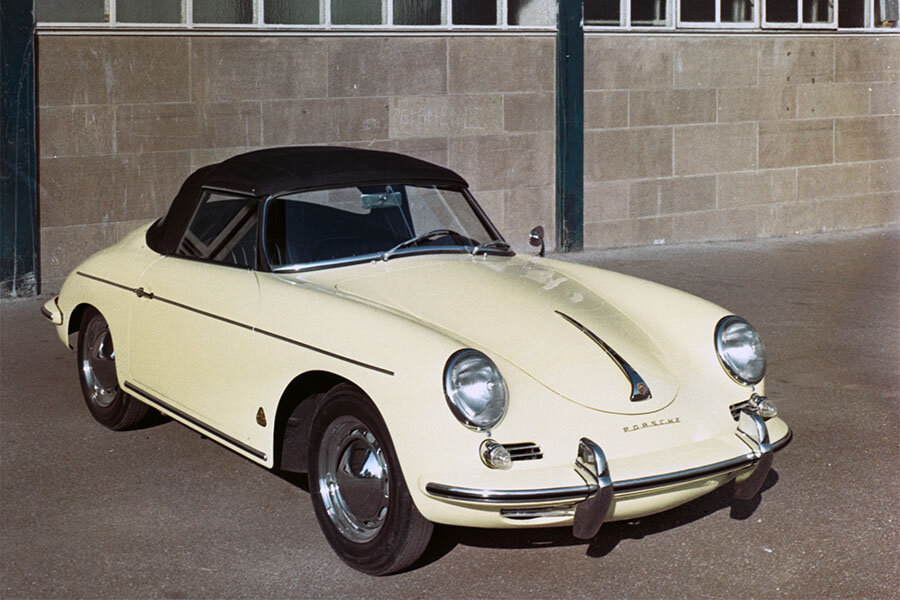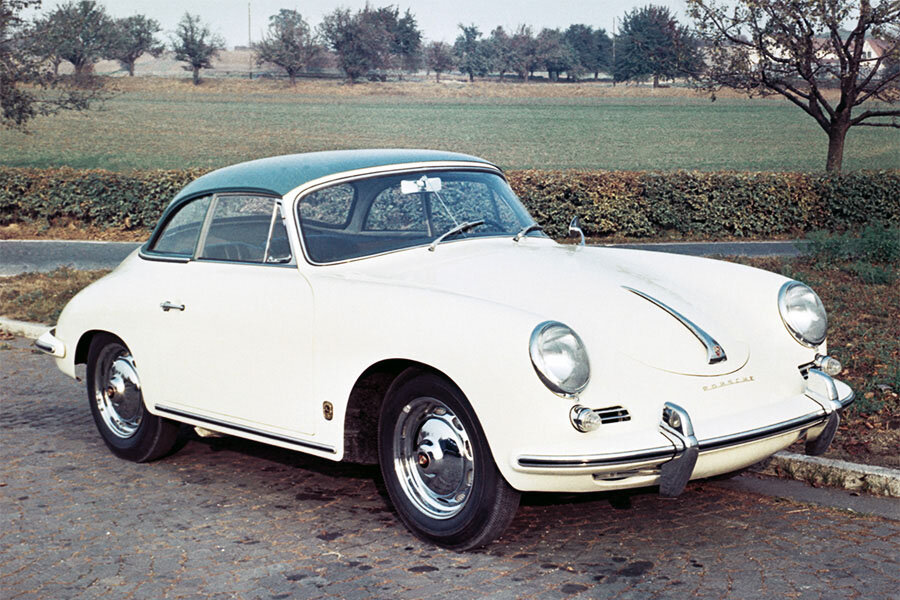Guide: Porsche 356 B - a Historical & Technical Appraisal
/BACKGROUND
Since its 1948 introduction, the Porsche 356 had proved a runaway success.
Ferry Porsche had originally anticipated a production run of 500 would satisfy demand but, by late 1959, over 30,000 had been manufactured in a variety of different configurations.
Despite its unconventional rear-engined layout, quirky styling and unusual air-cooled engine, the 356 initiated Porsche’s inexorable rise to an international powerhouse of industry.
The model offered exceptional build quality and sizzling performance, the latter perfectly demonstrated by countless wins in races and rallies.
At the Frankfurt Motor Show in September 1959, Porsche launched the 356 B. It featured a number of visual and mechanical updates but retained the essential Porsche DNA that made the 356 such an attractive proposition.
Two variants were produced: the T-5 from September 1959 to August 1961 and the T-6 from September 1961 to July 1963.
Ignoring the expensive line of four cam Carrera derivatives (covered separately), customers could choose from three different engines that variously produced 60bhp (1600), 75bhp (1600 Super) and 90bhp (1600 Super 90).
Three body styles were also available: Coupe, Cabriolet and Roadster.
A curious short-lived variant known as the Karmann Hardtop was produced between 1960 and 1962 but this design (which mimicked the lines of a Cabriolet with a fixed Hardtop) did not prove very popular.
CHASSIS
Like its predecessors, the 356 B featured a steel unibody type assembly.
For this latest application, the floorpan was modified to accommodate a different gearbox linkage and new rear seats but was otherwise little changed.
Suspension-wise not much was different either. Fully independent all round, it used transverse torsion bars and trailing arms with additional swing axles at the rear.
The main change was made on the flagship Super 90 which came with a compensating rear spring to keep the back wheels as flat as possible under load. As part of the package, softer rear torsion bars were fitted (reduced from 24mm to 23mm). This arrangement was a cost option on the 1600 and 1600 Super.
Also present on the Super 90 were adjustable Koni springs. The combined effect of all these changes saw it become easily the best handling 356 yet.
Although by this time lots of manufacturers had begun to install disc brakes, for now, Porsche stuck with hydraulic drums. On the 356 B, they were modified with 72 axial fins that improved heat dissipation.
The steel wheels still measured 4.5 x 15-inches but new radial instead of crossply tyres further improved roadholding.
Hub caps with the Porsche crest were standard on all bar the entry level variant.
As usual, a 57-litre fuel tank was mounted underneath the front lid.
ENGINE / TRANSMISSION
Aside from switching to Zenith 32 NDIX carburettors, the 1600 and 1600 Super engines were left practically unchanged and retained the same type numbers used before. Super 90s ran the Solex 40 PII-4 carburettors fitted to the Carrera.
One change made to all 356 B engines saw the cast-iron rocker arms replaced with alloy components.
Displacement of all three engines remained at 1582cc thanks to a bore and stroke of 82.5mm and 74mm respectively.
Specifications were as follows:
1600: Type 616/1, 60bhp at 4500rpm / 80lb-ft at 2800rpm, 7.5:1 compression, two Zenith 32 NDIX carburettors.
1600 Super: Type 616/2, 75bhp at 5000rpm / 85lb-ft at 3700rpm, 8.5:1 compression, two Zenith 32 NDIX carburettors.
1600 Super 90: Type 616/7, 90bhp at 5500rpm / 89lb-ft at 4300rpm, 9.0:1 compression, two Solex 40 PII-4 carburettors.
Unlike the other two engines, the Type 616/7 unit found in the Super 90 featured a host of upgrades. These included more substantial rods, larger main bearing journals, bigger inlet valves, re-worked light alloy cylinder heads and light alloy cylinder barrels instead of cast iron. This motor was immediately identifiable by its silver instead of black fan housing.
Porsche’s four-speed manual gearbox now incorporated a single nose mount for easier production and maintenance. The Super 90 came with a thicker Haussermann clutch to cope with its higher output.
BODYWORK
Undoubtedly the most obvious changes introduced on the 356 B were cosmetic.
The nose and front wings were both reprofiled with the headlights mounted flatter and higher up than before.
New domed indicators were fitted while the horn grilles were dropped in favour of two alloy slats mounted within an oval cutaway.
Brake cooling intakes were carved out from the lower nose panel.
The front lid became more heavily contoured at its leading edge and had a wider handle.
Bigger bumpers were moved higher up than before and came with suitably enlarged overriders.
Slimmer sill strips were mounted down each flank.
Coupes came with opening quarterlights. Like the Cabriolet, these bodyshells were fabricated by both Reutter and Karmann while Roadsters were executed by Drauz and the Belgian importer, Anciens Etablissement d’Iteren Freres.
INTERIOR
Inside it was a case of evolution rather than revolution.
The dashboard was largely unchanged but did come with new black plastic switchgear and a clock in the centre.
A dished black plastic-rimmed three-spoke steering wheel was fitted along with a slimmer combined indicator / headlight flasher on the steering column.
A shorter gear lever was installed and the rear seats were now split in two which allowed the bases to be lowered thus optimising headroom.
Coupes came with demisting outlets either side of the rear window and Cabriolets were upholstered with leather trim as standard.
OPTIONS
Myriad options included a wood-rimmed steering wheel, a sunroof, perforated seat faces, a 70-litre fuel tank and a choice of audio systems. Many of the lightweight competition parts from the Carrera could also be fitted at special request.
WEIGHT / PERFORMANCE
Performance figures for the 1600 and Super were comparable with the outgoing 356 A variants.
Top speeds were 103mph and 110mph with 0-62mph times of 15 and 14 seconds respectively.
Meanwhile, the Super 90 could hit 120mph and achieve 0-62mph in 11 seconds.
PRODUCTION CHANGES
As the single rubber mounting on the nose of the gearbox created too much noise and vibration, Porsche reverted to twin mounts at the beginning of 1960.
The alloy rocker arms designed to improve acceleration were also found to have the opposite effect so they were switched back to cast iron.
Crankshaft failures in some early 356 Bs left Porsche with no option but to fit a new oil pump to enlarge capacity.
In August 1960, a fourth body style was introduced: the Karmann Hardtop Coupe. Built by Karmann in Osnabruck, these cars used standard Cabriolet bodyshells with a hard top welded permanently in place.
Production of the 356 B continued until September 1961 when Porsche replaced the T-5 with the T-6.
356 B T-5 REPLACED BY T-6
Unveiled at the 1961 Frankfurt Motor Show, it was the T-6’s body and interior that came in for the most attention.
Most easily identifiable was the enlarged engine lid which now came with two cooling grilles instead of one.
The T-6 also came with a larger windscreen (and a bigger back window in the case of the Coupe) plus a thicker alloy surround.
Air intakes were added on the front scuttle to improve cabin ventilation (excluding the Roadster) and were controlled by a lever on the centre of the dash.
Left-hand drive cars now came with a spring-loaded fuel filler cap on the right-hand front wing which meant the bonnet no longer had to be opened to refuel. This update was not made to right-hand drive derivatives because the steering column was in the way.
The front lid was made wider and flatter at its leading edge while the trunk now came with a plastic liner.
To improve luggage space, a flatter fuel tank was installed (LHD only) and the spare wheel and battery were repositioned.
Cockpit changes included a shorter gear lever (which was now chrome plated rather than painted silver), a rear view mirror with switchable anti-dazzle facility and a matt instead of bright finish handbrake.
A zip was added to the Cabriolet’s hood so the rear window could be removed and the manual sunroof option was dropped in favour of electric.
Adjustable Koni dampers were now fitted as standard across the board.
The Super 90 lost its ‘Super’ tag and was re-branded simply as ‘90’. It now came with a thicker clutch plate while the 75bhp engine was given a new type number (616/12) but remained technically unchanged.
In June 1962, the Karmann Hardtop and Roadster were dropped owing to poor sales.
END OF PRODUCTION
Production of the T-6 continued until July 1963 when the 356 C was launched.
By this time over 31,000 356 Bs had been built.
T-5 production comprised 8559 Coupes, 3094 Cabriolets, 2653 Roadsters and 1048 Hardtops.
T-6 production comprised 12,138 Coupes, 3100 Cabriolets, 200 Roadsters and 699 Hardtops.
One final incarnation of the 356 was manufactured (the 356 C) before Porsche switched over to its highly anticipated replacement: the 911.
Text copyright: Supercar Nostalgia
Photo copyright: Porsche - https://www.porsche.com


































